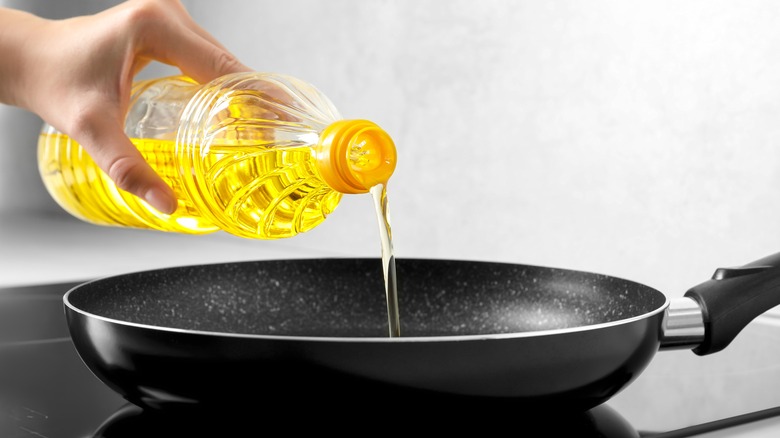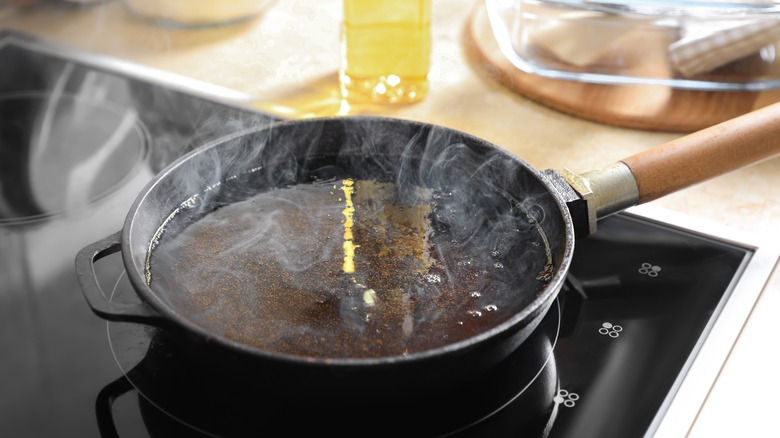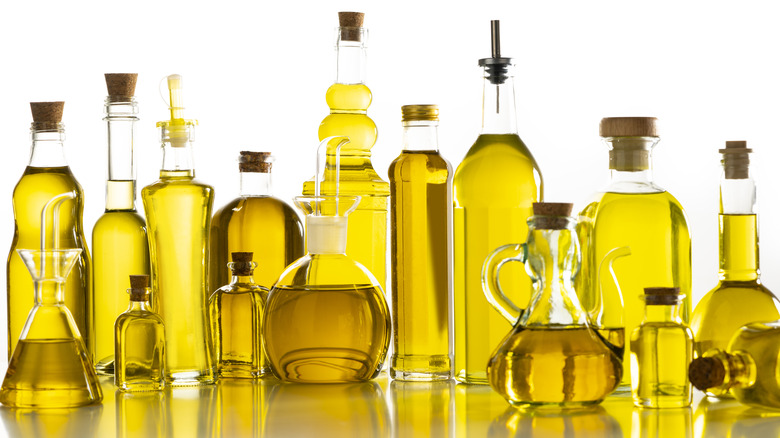Why You Should Never Add Good Oil To Cold Pans
Whether you're making a sauce, sautéing vegetables, or searing meat, you're probably starting by heating oil in the pan in the stovetop — and this step requires more attention to detail than you think. If you want to get your cooking done fast, you might pour oil into the pan and start heating it up, but for best results — especially when using high-quality good oil — the pan should be heated first and oil should be added afterward.
Per a 2022 study by BMC Chemistry, applying heat to oil initiates a series of chemical reactions that cause the oil to degrade, with effects including the loss of flavor compounds and nutrients. This is why you want to minimize the amount of time that the oil spends in contact with heat. It is especially important to avoid exceeding the smoke point of your oil, or the temperature at which it will begin to burn and emit smoke. This is doubly true if you're using good, expensive oil, and you want its flavor to come through in the final dish.
When your high-quality oil is overheated, its unique taste and aroma are compromised and it becomes irreversibly and unpleasantly bitter. Moreover, heating oil until it produces smoke can be harmful for your health. For instance, while olive oil is renowned for its high antioxidants and vitamins, once it is heated beyond its smoke point, it may contain free radicals that can injure your cells and DNA (per The Health Sciences Academy).
How to tell if your pan is hot enough, without any sizzling oil
Heating your pan to the correct temperature for cooking, without any sizzling oil to tell you it's hot enough, might seem a bit complicated. The truth is that you don't even need a thermometer to tell when you can add your meat, veggies, or other ingredients. After heating the pan for about a minute, drop a teaspoon or so of water onto the surface. If the water sits still in the pan or slowly sizzles, it's not ready yet, and you should give it another minute before trying again.
You'll know the pan is perfectly hot when the water immediately forms into beads upon contact, gliding swiftly across the surface and evaporating as steam soon after. At this point, you can pour in your oil. Give the oil a few seconds to warm up, then tip the pan slightly to easily coat the surface in an even, shimmery layer. Add your ingredients ASAP, so the oil doesn't get a chance to overheat and start smoking. It might take a little longer, but this way of doing things ensures that your oil retains its flavor, without adding a bitter taste to your food or setting off your smoke detector.
Choosing good oil and making good use of it
When we think of premium oils, olive oil usually comes to mind, and many bottles undergo strict standards for quality assurance. Olive oil is indeed a flavorful, nutritious, and versatile option, but it is not well-suited for cooking at high temperatures, as it doesn't have a high smoke point, and its flavors and nutrients will be destroyed by the heat. Thinking about the smoke point in addition to the flavor of an oil is useful when choosing one for a meal. A nice olive oil should be saved for dressing a salad, or garnishing finished dishes.
When cooking food at high temperatures, try canola or sunflower oil, which have smoke points of 400 and 440 degrees Fahrenheit respectively. As with olive oil, search the label for the term "first cold pressing," which indicates that heat was not used in the extraction process, resulting in a minimally-refined product. These neutral oils may not seem fancy, but it's still wise to shop for the best options.



